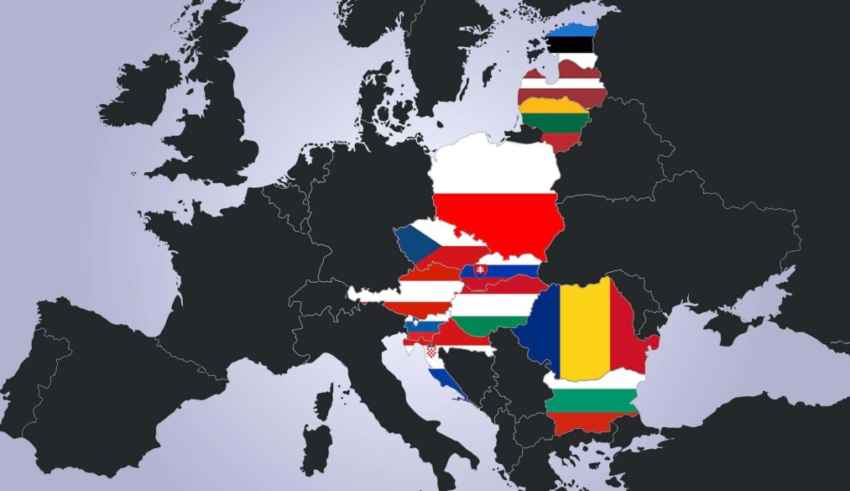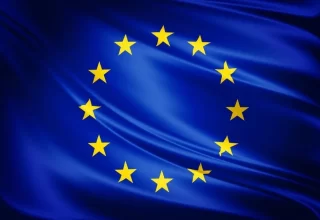
The ambitious Three Seas Initiative known as 3SI has been structured as a regional effort in Europe to expand cross-border energy, transportation, digital infrastructure and to boost economic development among twelve EU Member States located between the Baltic Sea, the Black Sea and the Adriatic Sea: from North to South, encompassing Estonia, Latvia, Lithuania, Poland, Czech Republic, Slovakia, Hungary, Austria, Romania, Bulgaria, Slovenia and Croatia.
The Origin of 3SI
The platform was launched in 2015 initiated by the President of Croatia and Poland (Zbińkowski, 2019). The purpose of such reconciliation was articulated in significant asymmetry in economic development between the central and the so-called ‘Old Union’ (Calheiros, 2019). The common characteristic that these central and eastern European countries share, in some respects, is their belonging to the Soviet Union regime, the socialist bloc that led to a slow transition on market-based economic model compared to the Western European countries (Raik, 2004). Their poorly connected energy and transport infrastructure reflect the legacy of the Soviet Union’s Cold War-era dominance over most of the region, in particular their separation from Western Europe by the Iron Curtain during the long decades of the Cold War (Barta, 2013). It needs to be mentioned, that the first initiative for political and economic cooperation between the nations of Central and Eastern Europe was set up immediately after the end of WWII. The aim of the consortium was to counteract immediate threats facing member nations from totalitarian countries – Germany and Soviet Russia, to act as a sort of barricade between Moscow and Berlin and prevent these two politically aggressive countries from attaining a common border (Przygoda, 2017).
However, such union was not welcomed by the potential member states then, perceiving it as a threat to their independence and sovereignty. Moreover, the opposing states imagined it as an attempt to recreate the Polish-Lithuanian Commonwealth with a dominating governance from Warsaw (ibid). Considering the multiple controversial opinions related to such union, all plans of consortium came to a halt and the candidate countries had fallen into the dominance of the Soviet Union or Nazi Germany within two decades (Calheiros, 2019). Despite the global conflict and ongoing confrontations between the Soviet and Nazi blocs, the idea to unite Central and Eastern European countries into a solid bloc of economic and political cooperation survived and it took a tangible shape after the dissolution of the Soviet Union and the dissolution of Yugoslavia (ibid). After a short while, the need for the unification reappeared in the international political scene and this time, the initiative was much welcomed by the candidate countries, as well as by the UN general assembly – agreed to an attempt at creating a new, large-scale political and economic platform to bond the countries between the three seas (Atlantic Council 2018, “The Three Seas Initiative Explained”).
What 3SI is promising
This central and east European grouping is meant to modernize and to globally connect the infrastructure of the Central and East European nations including roads, rails, ports, as well as digital architecture and sustainable energy (Przygoda, 2017). The geopolitical importance of this project is immediately evident from the fact that many of these countries are landlocked states with no access to the sea. These infrastructures will now give them access to three seas and thus contribute to greater independence and room for manoeuvre in their policies (Kurečić, 2018). Apart from that, the area of the Three Seas Initiative geographically coincides the so called ‘buffer states’ territory, which has long been confrontation between the superpowers as the one who will exercise control over this area will occupy a leading position in the competition for world domination (ibid). In this aspect, the 3SI introduced a new reality, redefined the existing strategic assumptions and prevented a single power domination in the region.
Another objective of the 3SI is to reduce regional disparities within the EU, between the core and the periphery of Europe (Thomann, 2019). For this purpose, Investment Fund – a mechanism intended to draw in private-sector financial support, was launched in 2019 with an initial commitment of €500 million (about $602million) from development banks in Poland and Romania (The Congressional Research Service (CRS), 2021). As of April 2021, 9 of the 12 3SI countries have pledged contributions totalling about €1 billion ($1.2 billion) (ibid). The EU has also allocated more than €150 billion (about $180billion) in regional development and cohesion funds to the 3SI countries under the EU’s 2014-2020 budget framework (ibid). Over one-third of this amount was for investments in transport, energy, and digital connectivity projects (ibid). Through investing programs, 3SI strives for replacing the East-West trade direction with north-to-south vertical connections and achieving the level of international relationships already present among the nations of Western Europe (Przygoda, 2017).
Furthermore, the member states of 3SI made clear declarations that 3SI is not an alternative or a competitor to the EU and neither does it represent a threat to its unity during the very first summit in Dubrovnik (2016) and later in Warsaw (2017) (The Three Seas Initiative Summit). In their official statements, the member states always highlight the fact that the only idea of the platform is to boost the potential of the entire region and to strengthen the economic bonds between the countries (Thomann, 2019). The three identified sectors include transport, power engineering and telecommunications. Accordingly, funds were concentrated on areas such as research and innovation, supporting low-carbon economy, digital technology, balanced management of finite resources and small businesses (Przygoda, 2017). 152 projects totalling over 45 billion euro have been planned for the next few years as part of the Three Seas Initiative. The first stage includes investments based on the initiatives from Poland and Croatia in three main areas: power engineering, logistics and transport, as well as IT and telecommunications. The second largest area of investment planned within the Three Seas Initiative is power engineering – over 14 billion euro across 66 programmes will be used to develop it (Przygoda, 2017).
During the latest Sixth Summit in Sofia (2021), the countries in their joint declaration emphasized the importance of strengthening energy security and diversification of routes and sources, together with the just transition to climate neutral energy sector. Alongside, developing trans-border and cross-regional projects (The Three Seas Initiative in 2021).
International response
While the 3SI has gathered supporters inside the European Union, it has also provoked significant interest at international level (Thomann, 2019). The Russian federation sees hidden interest of the United States in the creation of the Three Seas Initiative and for Russia, 3SI is a direct obstacle to the implementation of their strategic plans to control its former, Soviet-era occupied territories (Kurečić, 2018). One precondition of which is reducing the energy dependence of the region’s countries on the raw materials supplied by Russian companies. Not surprisingly, the Russian federation never approves the platform as it confronts Russia’s neo-imperial aspirations in Central and Eastern Europe.
On the contrary, the US has expressed its full support for the Three Seas Initiative and backed the project at several platforms (Chojan, 2019). President Donald Trump even attended the Summit in Warsaw, adding extra highlight to the importance of 3SI. Moreover, President Biden followed Trump’s policy in regard to 3SI pointing to an incredible potential for increasing cooperation and connectivity among this group that promises enhancing security and prosperity of the region (The Congressional Research Service (CRS), 2021). The US support reflects the primary geopolitical purpose behind the 3SI. This is an opportunity for the US to challenge Russia in its former zone of influence in Central Europe and promises added advantage of beefing up US trade and other interests in the region (Thomann, 2019). At the same time, 3SI looks like Central Europe’s answer to China’s Belt and Road Initiative, which is an ambitious foreign policy, covering economic and infrastructural sectors, aiming at strengthening Beijing’s economic leadership through a vast program of infrastructure building throughout China’s neighbouring regions (Grochmalski et al, 2021). Many experts and foreign policy analysts view this initiative largely through a geopolitical lens, seeing it as Beijing’s attempt to gain political leverage over its neighbours and in Central Europe.
Conclusion
Thus, the importance of 3SI is clear as in European realm so as at global level. Within the European continent it has potential to expand its presence among non-EU Black Sea states such as Ukraine, Moldova, Georgia or other Balkan countries and advance EU policies in this region through economic instruments or infrastructural projects. Such approach has strategic significance, considering Russia’s manoeuvres and aggressive invasions in these countries. 3SI can be regarded as a solid and authoritative counter-power versus Russia’s dominance, ensuring stability in the development of the Central and East European region.
As for the global level, 3SI gives a leverage to the US to increase its influence and challenge China’s aspirations in respect to Belt and Road Initiative. However, the political debates around Three Seas Initiative in many countries is an ongoing issue. So far, the full potential of the 3SI has not been pushed and member states try to follow a mild path avoiding confrontations. How long this pace will last and whether 3SI reshapes existing geopolitical calculus remains an open question.
References
Atlantic Council (2018). “The Three Seas Initiative Explained”, accessed 8 September 2021 <https://www.atlanticcouncil.org/blogs/new-atlanticist/the-three-seas-initiative-explained-2/>,.
Barta, P. I. (Ed.). (2013). The Fall of the Iron Curtain and the Culture of Europe. Routledge
Calheiros, B. (2019). THE 3 SEAS INITIATIVE: GEOPOLITICS AND INFRASTRUCTURE. Janus. Net: e-Journal of International Relations, 10(2).
Chojan, A. (2019). The United States on the Three Seas Initiative. Rocznik Instytutu Europy Środkowo-Wschodniej, 17(3), 79-91
Grochmalski, P., Lewandowski, P., & Paszak, P. (2021). Three Seas Project (3SI) and the Belt and Road Initiative (BRI): The Security Dimension. European Research Studies, 24(1), 1230-1239.
Kurečić, P. (2018). The Three Seas Initiative: geographical determinants, geopolitical foundations, and Górka, M. (2018). The three seas initiative as a political challenge for the countries of central and eastern Europe. Politics in Central Europe, 14(3), 55-73.
Przygoda, M. (2017). The Three Seas Initiative as A New Important Factor in the Integration of Central and Eastern Europe. Economic and Social Development: Book of Proceedings, 657-673.
Raik, K. (2004). EU accession of Central and Eastern European countries: Democracy and integration as conflicting logics. East European Politics and Societies, 18(4), 567-594).
The Congressional Research Service (CRS), 2021 “The Three Seas Initiative”, accessed 8 September 2021< https://sgp.fas.org/crs/row/IF11547.pdf> .
Thomann, P. E. (2019). The Three Seas Initiative, a New Project at the Heart of European and Global Geopolitical Rivalries. Rocznik Instytutu Europy Środkowo-Wschodniej, 17(3), 31-63.
The Congressional Research Service (CRS), (2021). “The Three Seas Initiative”, accessed 8 September 2021 < https://sgp.fas.org/crs/row/IF11547.pdf>.
Three Seas Initiative Summit, accessed 8 September 2021 <http://three-seas.eu/previous-summits/> .
Zbińkowski, G. (2019). The three seas initiative and its economic and geopolitical effect on the European Union and Central and Eastern Europe. Comparative Economic Research. Central and Eastern Europe, 22(2), 105-119
By Nino Zotikishvili: The European Institute for International Law and International Relations.














